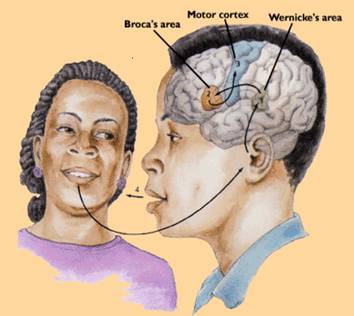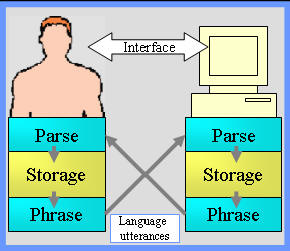| 1 Communication | 2 Elements | 3 Engine | 4 Small application | 5 Heavy application | 6 Download | 7 Notes |
![]() The
knowledge engine
The
knowledge engine

Communication between SEmantic Network Systems
by Harry Fitiι
AB Ontwikkeling BV.
Published 28-10-2005
Last update 01-05-2010
0.1 Introduction
CommunSENS is a software system that is based on the human communication cycle in order to accumulate knowledge on a computer. Its architecture is shaped by the structure of natural language and universal data storage. The software is fully scalable. For personal use, CommunSENS is freely available.
0.2 Communication cycle
The next figure summarizes the architecture of the communication cycle.
|
Observation: Most of the (declarative) knowledge people acquire in their youth and apply in their ordinary life is not devised by themselves but fabricated by wise men in past and present. This knowledge is transferred by means of communication. |
Purpose: To build a knowledge engine that can be a node in the human communication cycle. |
 |
 |
0.3 Natural language.
It will take some time, but one day people will talk to computers in their own language in a way that resembles human communication. To be prepared for that moment the communication cycle of CommunSENS is based on natural language. Although it is still a simple language, it can grow. At this moment substantial pieces of declarative code can be understand by people with no programmer skills.
0.4 Interface generation
In order to define knowledge, simple sentences are used. CommunSENS has a formal understanding of the meaning of these sentences, For that reason they are used to generate (a part of) the user interface. This generation results in a visual presentation of the sentences as forms with components. The logical navigation within forms and components is generated too.
0.5 Universal storage
The architecture of conventional database systems (tables, keys) depends on contents. The storage structure of a medical system will differ from that of a bookkeeping system. In contrast, humans are able to store all kinds of knowledge in their brain without bothering about its specific structure. In a similar way CommunSENS is equipped with a universal database that behaves as a semantic network. It has an architecture that is independent of the knowledge it has to store.
0.6 Logic and scalability
If a computer system will ever become a full partner in the human communication cycle, it should be able to talk about the same topics as humans. Most of the time these topics will be elements of every day life. They can be understood by applying conventional logic (proposition and first order predicate logic). However, humans also have much more abstract capabilities. For example, they can think about how they think. To process such complex constructions, higher order predicate logic is needed. The logic that is applied in CommunSENS can handle these kind of self referring mechanisms. This feature makes CommunSENS applications fully scalable: they can be build and updated while they are running.
0.7 Added value of CommunSENS
This scalability
of knowledge one also finds in humans. People can learn new
things or can update their existing knowledge 'at run time'. We do not rebuild
our selves in order to acquire new knowledge or
skills: we just add and modify it.
In contrast, conventional computer applications must be rebuild if their knowledge structure
and state fundamentally changes. The
added value of CommunSENS is this: it allows for variable knowledge
on a computer, at all
kinds of levels, at run time..
0.8 How to proceed.
There are three ways to proceed.
The preferred way is to download the software. After installation start the system and follow the instructions of the tutorial. The tutorial has some relevant links to this website .
If you just want a glance of the look and feel of the knowledge engine browse chapter 3 Engine. If you want a glimpse of some CommunSENS applications, browse through the chapters 4 (small application) and 5 (heavy application).
If you are interested in the overall picture, just proceed.
0.9 Contents
This web site gives a global introduction to CommunSENS. For more detailed information there will be some links to the notes section. The introduction contains the following topics:
| Topic | Summary |
| 1 The communication cycle | The classic physiology of the communication cycle is discussed. Roughly based on this physiology the main architecture of the knowledge engine is presented. This architecture is compared with today's use of computers. It will be pointed out in which fields this architecture has added value. |
| 2 Elements of the architecture |
The architecture of CommunSENS contains 3 main
building blocks - a formal natural language (Fonal). Knowledge is expressed in simple sentences. - an universal database that behaves as an semantic network; - a generated input interface. |
| 3 The knowledge engine |
- procedural: a small DLL that represents the working of the communication cycle. It does not have any contents. This part is not scalable. - declarative: the semantic network contains all data. Any application that is build with the engine is stored as data. For that reason you can update such an application while it is running. With the exception of the stored language, this part is fully scalable. Because CommunSENS it self is build by the engine, you can redesign the system as well. |
| 4 Building a small application |
A
small medical expert system is presented that contains three
parts:
-
the
logic of the contents (what are symptoms, illnesses, treatments?);
- the logic
of the presentation (components, properties, events);
-
the
definitions in simple declarative sentences and instances.
After parsing the sentences, the application is running. |
| 5 Building a heavy business rules application |
EU-Rent
is a
heavy business rules (BR) case. An
international company that rents cars throughout the world. To get the application
running it needs
-
53 subjects
(cars,
renters, etc.);
-
80 sentences;
-
51
small procedures.
The
EU-Rent application is linked to a taxonomy, a general description of
the world.
|
| 6 Download | You are invited to download the knowledge engine and try for your self. After downloading and running the engine you will enter the tutorial. If you follow the instructions of the tutorial you will get a good impression of the engine. |
| 7 Notes | This section contains notes about some technical aspects. |
| 1 Communication | 2 Elements | 3 Engine | 4 Small application | 5 Heavy application | 6 Download | 7 Notes |
Copyright © 2005 by AB Ontwikkeling BV
All Rights Reserved. Any reproduction or reuse of these pages or
their contents requires the advance permission of AB Ontwikkeling BV.